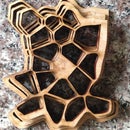Introduction: Lasercut-influenced Wood-turned Lamp-base
ok, ok, so you may well ask, what is this Illustrator dude on the wood lathe still talking about Illustrator?
I do know how to use other software, I'll have you know! But, after shredding the <insert-something-ominous-here>out of a cheap-ass piece of softwood on the wood lathe at Techshop the other day, I came to the conclusion I need to return to Guidance. Thats a capital G.
And that I did. I had lofty ideals of turning out a slick, chic base for a lamp, so what better way than using a reference when you are carving? I don't know much at all about technique when it comes to the wood lathe, but I do like a guide...
My idea was simple. cut out a stencil, or trace, on the laser cutter in cardboard, and use it to guide how you turn your piece on the wood lathe.
I made this at Techshop!
Step 1: Setup
So, lets begin, with a RGB Illustrator doc made to the dimensions of the piece of wood I picked up. My piece was 3/4" x 3" x 13, so I started by adding some guide lines, firstly one at the top of the piece and one at the bottom. make sure you display the Rulers (⌘ r) and the grid (⌘ ').
I wanted to draw a free flowing, organic curve that, when complete, could be mirrored to the other side. I would then laser cut that vector onto cardboard, which I would then use in the wood shop. In other words, after I finally get the piece cylindrical in the shop, I could have a guide that I made before hand to duplicate.
Again, I used the golden ratio - initially, to create nice vector curves that connected three sections on the piece, but then providing more segments to dictate where the curve dips in and out and at what rate. These can be really useful when you are first roughing out a design. You can make this job a little easier by using this link. As you can see in the image, I used ellipses as well to guide the placement of the vector paths.
I have also attached the AI file, for reference.
Attachments
Step 2: Setting Up the Wood
The next stage is to work out the center point for each end of the piece, so that we can mount it correctly on the lathe. You can do this by, with a pencil, drawing a line from corner to opposite corner on the block. Make sure you do both ends so you can line it up good and proper.
The next stage is to work out how to cut the square block of wood down to an octagonal shape, so it is as close to a cylinder as possible and thus less wood to chip away when it is on the lathe. To make an octagon, you just divide a square into thirds on both axes, then draw off the corners. But to get this accurate, I often use this handy link;
http://www.htmliseasy.com/octagon_layout/
After cutting the edges off on the miter saw, I always like to round the sides off a bit more on the sander, or you just go in for the kill with spindal turning on the lathe.
Next stage - start turning dat thang!
Step 3: Using the Cardboard Spencil to Guide
Once you have the roughed out cylinder you can start to pencil in reference points on the wood using the cardboard prototype taken from the laser cutter. I usually do with while the piece is turning on a very low speed and use the pencil around the whole circumference.
the great thing about the lathe is it starts and stops really fast. So using a guide is really helpful. You can even use it while roughing out a sketch, while on lower speeds. Its also good for sanding the piece, at the final stage - you can greatly influence the gradual slope of curves by sanding to the trace.
I didnt take a pic of it, but after I finished sanding, I used a technique I picked up from the Techshop teacher for using the sawdust/chips left over to give the piece a shine. You just use the waste lying all around you in your hand as sand paper (on a lower speed). great idea, dont you think? I call it poor mans sanding ;-)
Step 4: Final Stages
Since the piece is going to be the base of a lamp, I need to drill a hole down the center to allow for the power cord. Then I need to carve out the recess on top where light bulb will fit and a groove on the bottom to allow for the cord to come out.
But that is for next time... :-)














